Ah, Kathmandu. Krazy Town. Love it.
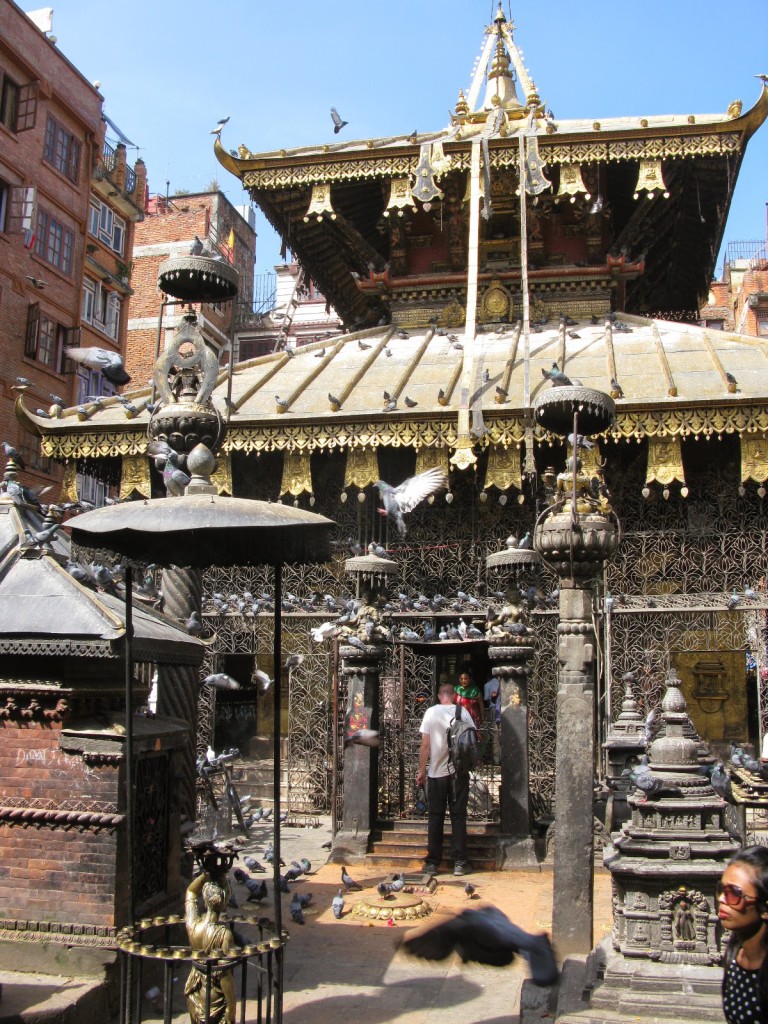
One of Kathmandu’s many temples
Circling the Kathmandu Valley waiting for a landing slot, our view was of hills higher than any we had seen on the trip so far, even the volcanoes of Java and Bali. They were not however as high as some that we had passed before our descent into the valley – giants poking their snowy heads above the clouds to delight passengers and remind pilots to concentrate. The hills enclosing the Kathmandu Valley were not snowy – they just looked wet. With the dark grey clouds above and churning brown rivers below, the whole place looked dispritingly soggy. Evidently the rainy season was not yet over.
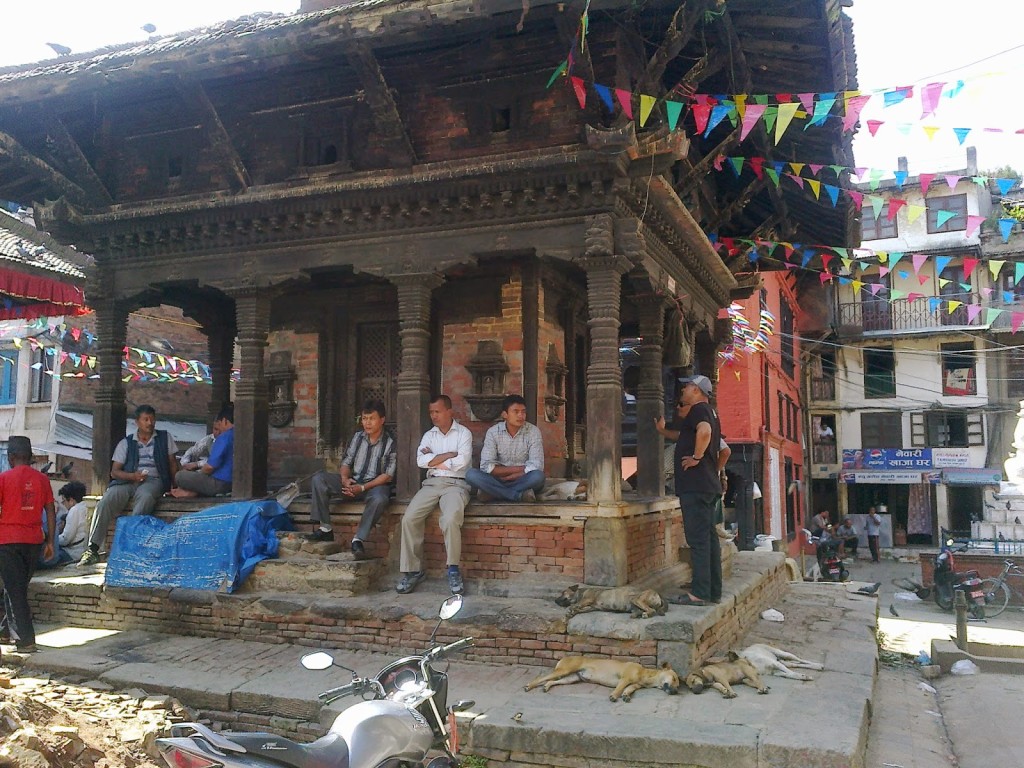
Residents take Kathmandu’s heritage buildings for granted
We had asked for a hotel pick-up – it was only the same price as a prepaid taxi and it would ensure that the driver could find the Happy Home among the hundreds of guesthouses in Thamel’s warren of narrow, crowded lanes. It’s only 7km from the airport to Thamel, but it took almost an hour as we were in a traffic jam the whole way. Apart from driving more or less on the left there appeared to be no road rules, and our driver darted for any scrap of space that he spotted that would move us forward a few feet. At one point he drove quite some distance along the muddy verge, one set of wheels practically in a ditch, until forced back onto the tarmac by an inconvenient concrete post. He didn’t show the slightest concern for his suspension – probably because he no longer had any.
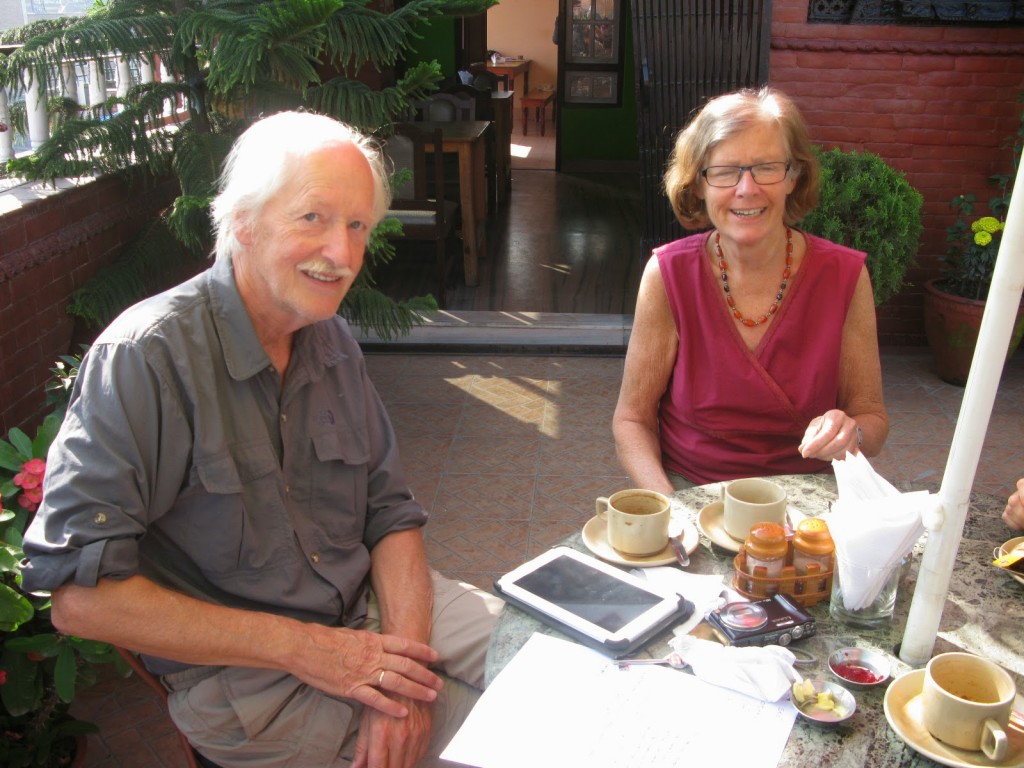
Per and Trine at Happy Home
Our room at the Happy Home wasn’t as large as the one we had supposedly booked, nor did it have the promised fridge, but we were told we could move the next day and thankfully it was on the 3rd floor – one less flight of stairs. Unfortunately the fridge in the new room didn’t actually work, and although the staff were delightful none of them showed any interest in getting it fixed – so we just had an ant-proof food cupboard. The small rooftop terrace, 6 floors above the street, was the venue for breakfast and afforded a view over Thamel to the hills beyond. It was also the place where we met Per and Trine, a Norwegian couple comprising a retired history professor and a not yet retired teacher, in whose company we were to spend many hours over the following 3 days engaged in non-stop conversation about Norway, Britain, and the rest of the world.
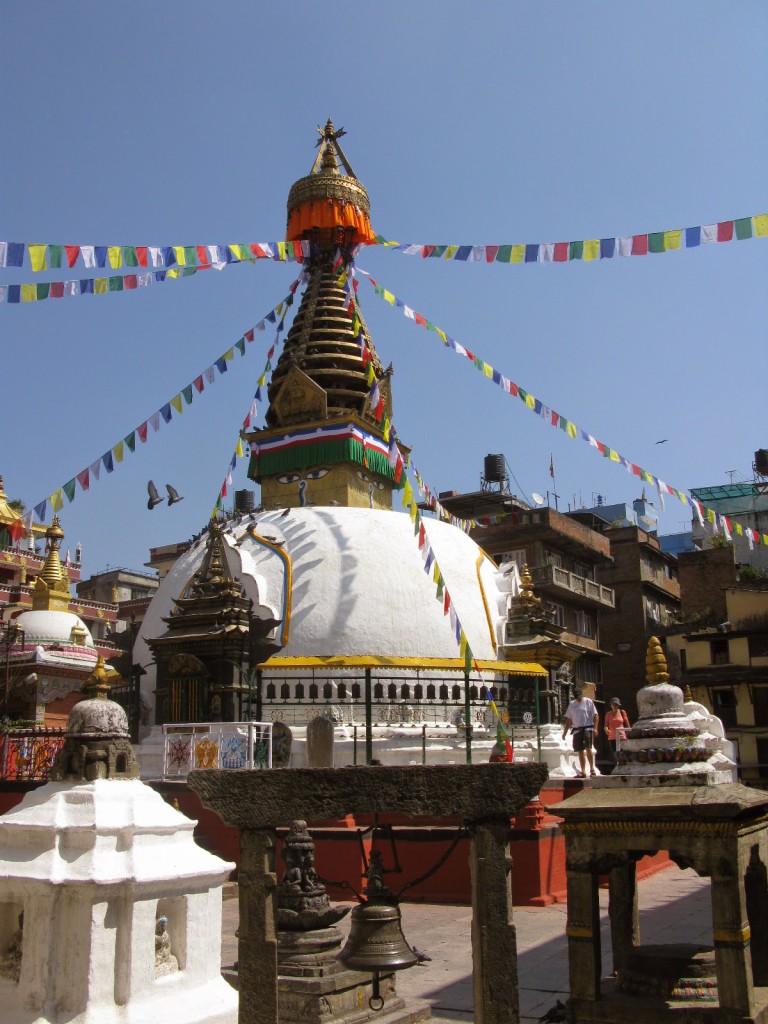
The famous stupa is Boudnath, but there are many others
We had only booked a week at the Happy Home – we had asked if we could stay longer but never got a defnite reply, and given that we were paying for a room with AC that we didn’t really need and a fridge that didn’t work, we decided to look elsewhere. We had assumed we would just get a room somewhere, but the Tayoma, a few doors from Happy Home, showed us an apartment. It was nothing like as nice or as well equipped as our previous apartments, and came with an unwelcome layer of grime, but we figured that even if we mostly dined out it was worth having it for the extra space and comfort. There’s just something very appealing about being able to make your own breakfast and potter around without getting properly dressed until late morning – I suppose it gives me an ‘at home’ feeling. An apartment also gives space for guests, and Per and Trine came back for a drink after dinner on their last evening before their departure for India. They left about 11pm – and returned at 11.20 having found the Happy Home all locked up and being unable to rouse anybody. Mr V went back with them to try again but to no avail, and they ended up taking a room at the Tayoma. Luckily they didn’t have an early morning flight!
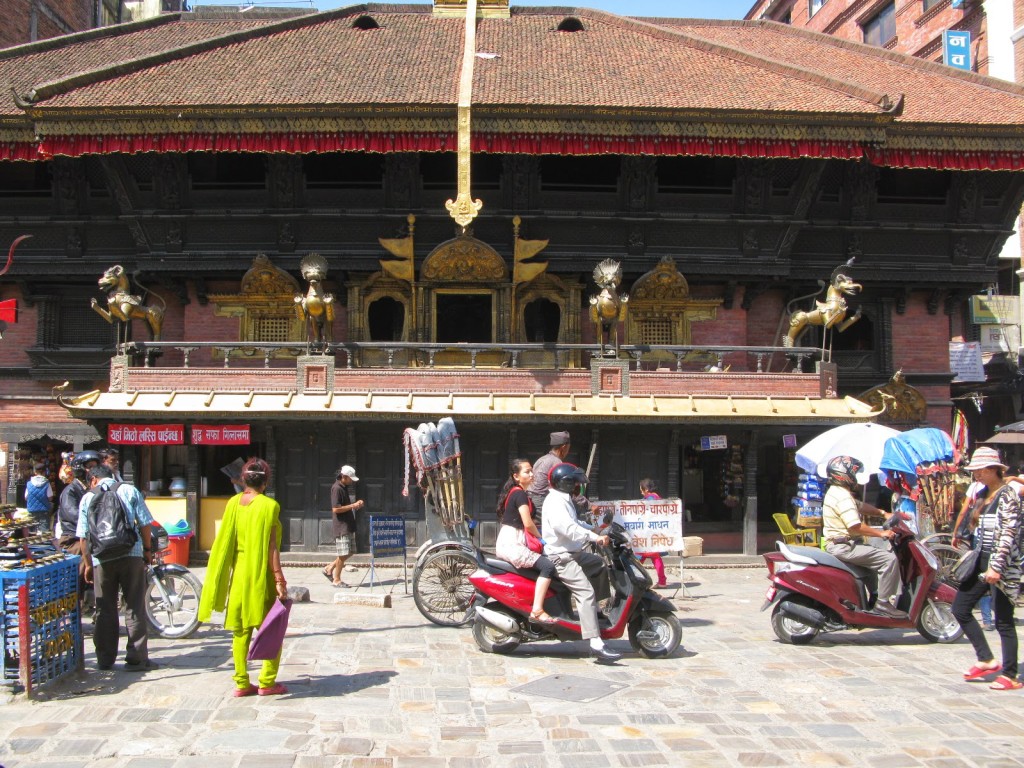 Top of our to-do list in Kathmandu was getting an Indian visa, which required three trips to the visa office, about 20 minutes walk north of Thamel – one to hand in the forms and pay the quite unreasonable amount of (non refundable) money that is demanded of British citizens (everybody else pays far less apart, bizarrely, for citizens of Mozambique who pay even more than we do), one to hear the verdict (we hadn’t even bothered to ask for 6 months, knowing that they don’t give more than 3) and hand over our passports, and then finally to collect them back. But before the first visit the forms had to be filled out online, submitted electronically and then printed – a tedious task that took most of the day because the discovery of the tiniest error in the lengthy and complicated form meant starting all over again. With a whole month to play with, we were confident of geting our visas in plenty of time, even though we knew that the office would be closed for the whole of the first week of October because of various festivals.
Top of our to-do list in Kathmandu was getting an Indian visa, which required three trips to the visa office, about 20 minutes walk north of Thamel – one to hand in the forms and pay the quite unreasonable amount of (non refundable) money that is demanded of British citizens (everybody else pays far less apart, bizarrely, for citizens of Mozambique who pay even more than we do), one to hear the verdict (we hadn’t even bothered to ask for 6 months, knowing that they don’t give more than 3) and hand over our passports, and then finally to collect them back. But before the first visit the forms had to be filled out online, submitted electronically and then printed – a tedious task that took most of the day because the discovery of the tiniest error in the lengthy and complicated form meant starting all over again. With a whole month to play with, we were confident of geting our visas in plenty of time, even though we knew that the office would be closed for the whole of the first week of October because of various festivals.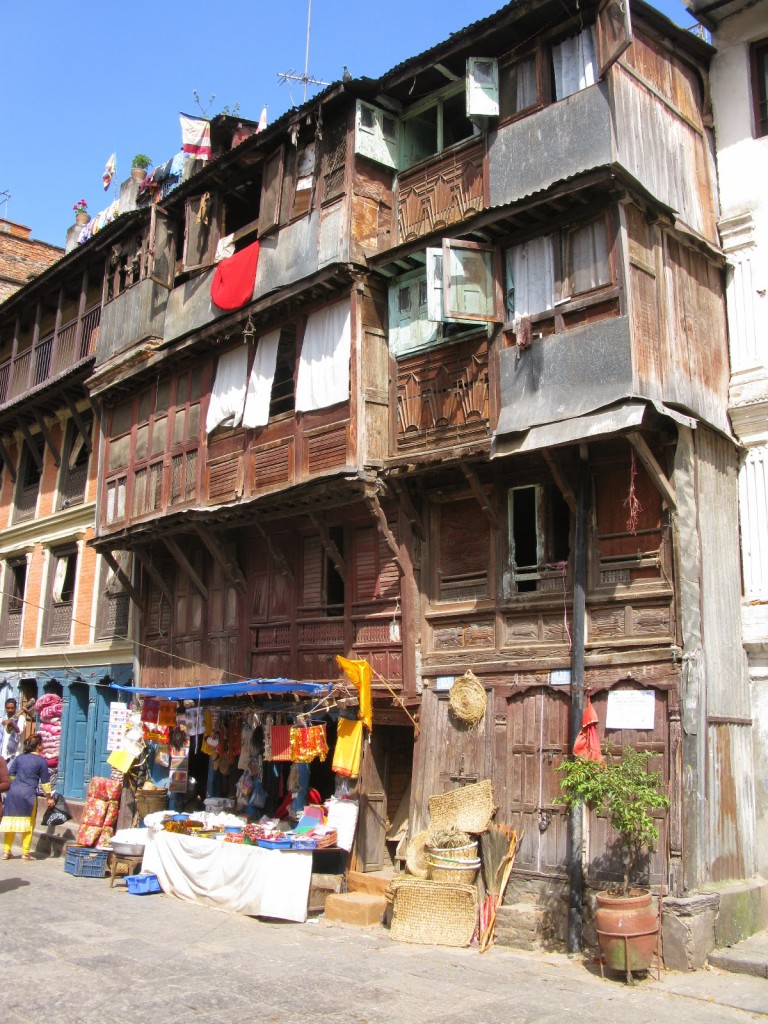
Buildings like this would be stunning if restored
It wasn’t completely intentional – it just happened that once we’d allowed enough time to get the visas the price of flights to Delhi was rather high (the build up to Diwali), so we picked a later date than we really needed. Besides, it was still pretty hot in Delhi, so we thought we might as well use the full duration of our visa.
The irony of slow travel is that, with all that time to spare, I’ve found that I actually feel less obliged to do The Sights than when I am on short trips. I suppose if I hadn’t been to Nepal twice before, and both times visited the 7 Kathmandu sites plus Pokhara and Chitwan, I would have slogged up Swayumbanath hill and gawped at the Pashupatinath cremation ghats along with every other Kathmandu visitor. But, unlike on previous visits, tourists now have to pay to visit all these sites, even though some of them are an integral part of the town centre. It’s like London charging people to walk through Piccadilly Circus. What’s more, western tourists pay more than those from neighbouring Asian countries, as there is a presumption that we are all rich – whereas in reality there must be millions of Indians who are richer than we are. It’s fair enough that Nepalese people pay nothing, and I understand that an impoverished country can’t pass up an opportunity to make a little revenue, but the prices charged to westerners are becoming offputting. Bhakthapur, a well preserved old town a few kms from Kathmandu, is now a whopping £10 each – which may not sound much but to put it into context, £10 would buy you a quite reasonable ensuite hotel room for the night, or a slap-up meal for 2 with beer in a swanky restaurant, or 5 Nepali cotton shirts. So, having been twice before, we didn’t go. We did fork out the lesser sums demanded for the Boudnath stupa and the durbar square in Patan, and we did go to Kathmandu’s durbar square – we just didn’t pay! The first time it was a bit accidental – we thought we were just walking along the side of it, so ignored the ticket booth, then found ourselves in the actual square. Oops. Then on our last day we ended up near another part of the square in the late afternoon, the day before Diwali. The sun was beginning to go down and the square was crowded with temporary market stalls and Diwali shoppers, so we just sauntered in trying not to look shifty.
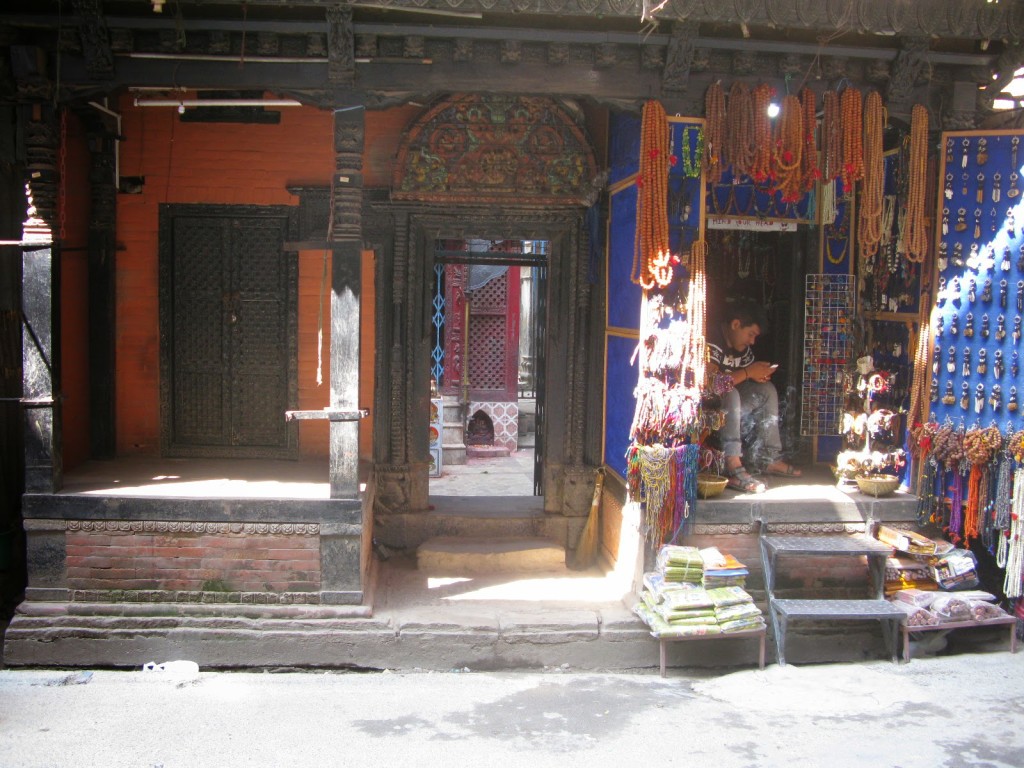
So much in Kathmandu is hidden away
The Sights are nice, but the real joy of Kathmandu is just wandering the streets in the old part of town, discovering corners and courtyards containing temples, stupas and shrines that in most places would qualify as Sights, but in Kathmandu are just part of the urban landscape. Rickety, centuries old buildings with overhanging roofs and ornately carved wooden windows are two a penny, resulting in a street scene that looks as if it would come straight out of a historical movie if you just stripped away the electricity cables and hoardings. Unfortunately the fact that they are regarded as nothing special means that they are often left to crumble into an unrepairable state.
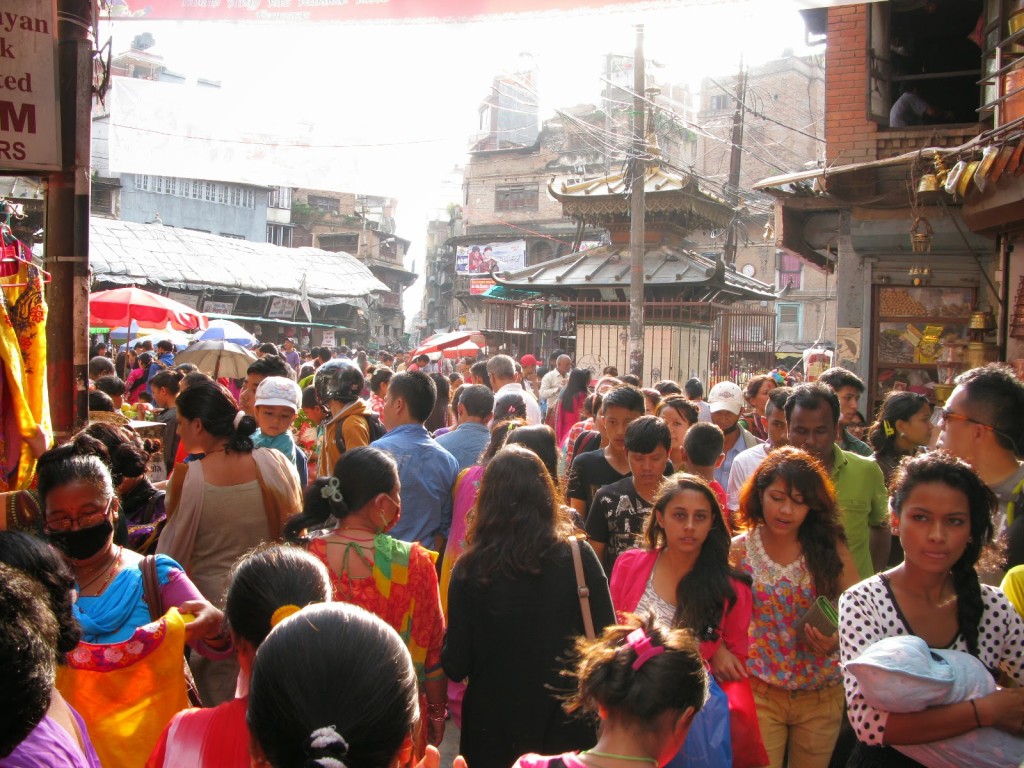
Diwali shopping – like Christmas shopping, but warmer
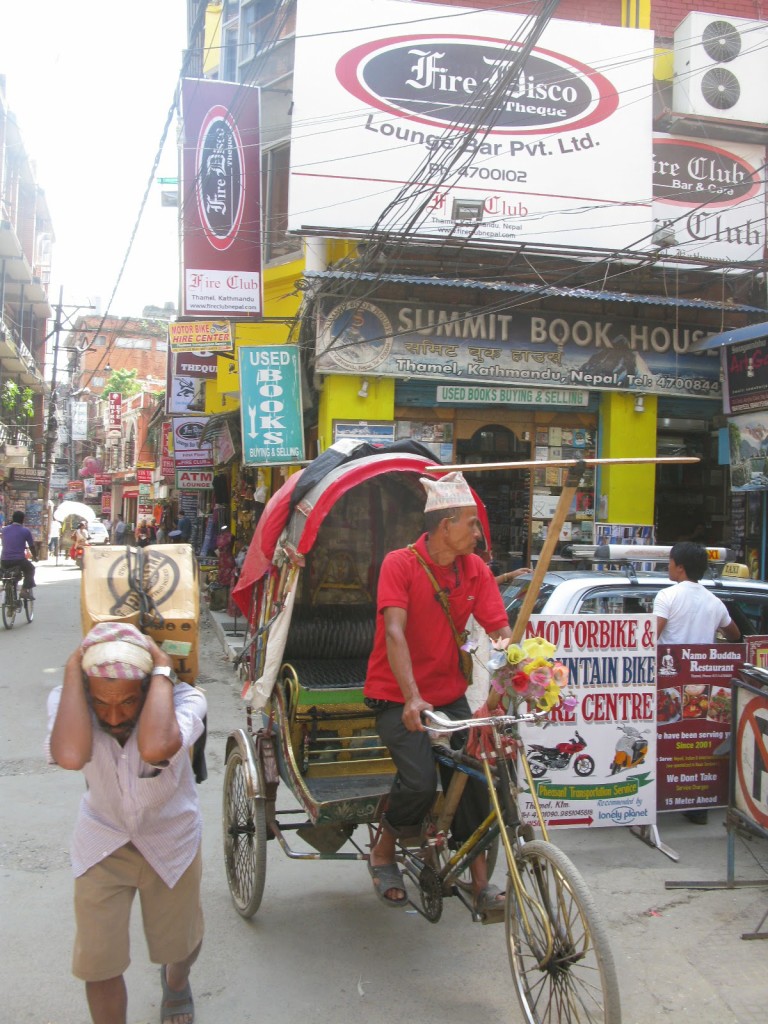
Human powered transport is still very much in use – most porters don’t work for trekkers, and even the ones who do only do so for a few weeks a year
The major drawback of walking around Kathmandu is the traffic. The four wheeled variety is bad enough, but at least they stick to the roads (more or less) and go fairly slowly. Motorbikes are another story – they whizz along narrow streets crammed with pedestrians and just expect people to get out of their way. I am amazed that we didn’t witness any collisions. Not all the lanes are sealed, so an enormous amount of dust is kicked up, to the extent that locals and tourists alike resort to masks, even in October – the problem apparently worsens as the dry season progresses. For now, the dust is not so bad that it affects the views, so the vista of sunlit snowy peaks from the windows on the starboard side of the plane as we flew to Delhi was spectacular enough to remind me why people venture into the mountains in spite of the risks.
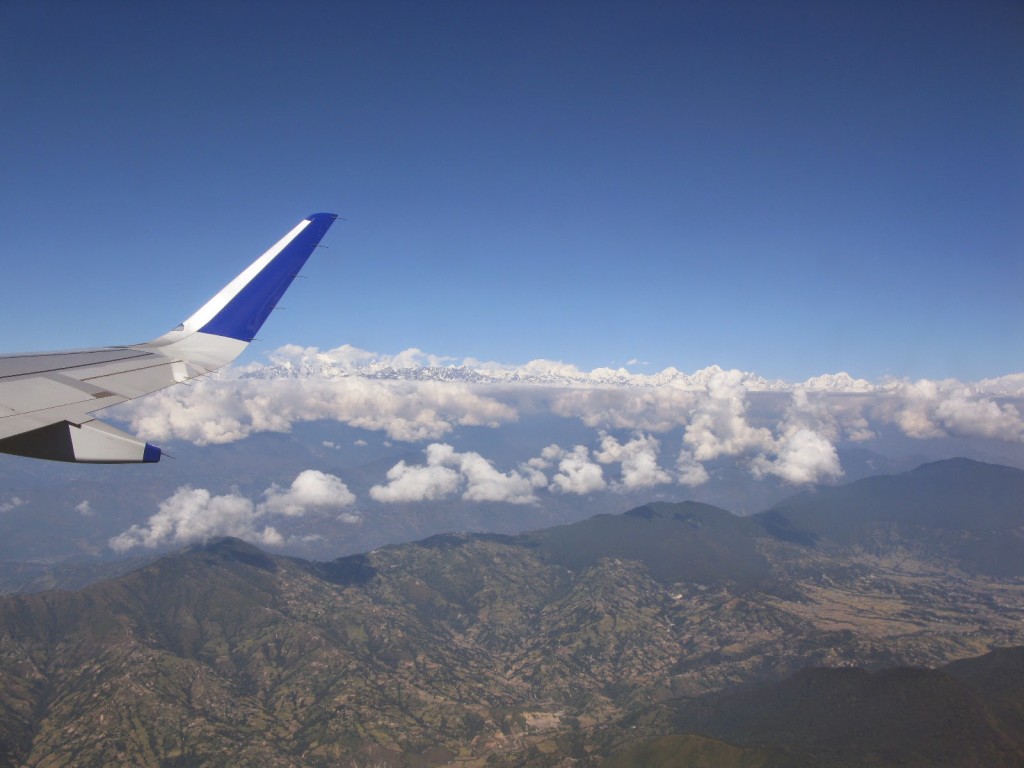
If flying from Kathmandu to Delhi, be sure to sit on the right!

